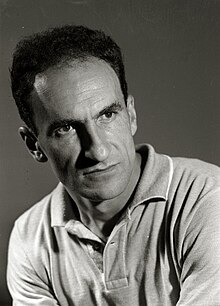Eduardo Chillida
| Eduardo Chillida | |
|---|---|

Eduardo Chillida
|
|
| Born |
Eduardo Chillida Juantegu 10 January 1924 San Sebastián |
| Died | 19 August 2002 (aged 78) |
| Nationality | Spanish |
| Occupation | Sculptor |
Eduardo Chillida Juantegui, or Eduardo Txillida Juantegi in Basque, (10 January 1924 – 19 August 2002) was a Spanish Basque sculptor notable for his monumental abstract works.
Born in San Sebastián to the major Pedro Chillida and the soprano Carmen Juantegui on 10 January 1924, Eduardo Chillida grew up near the Biarritz Hotel, which was owned by his grandparents. Chillida had been the goalkeeper for Real Sociedad, San Sebastián's La Liga football team, where his knee was so seriously injured that he had five surgeries, ending a promising football career. He then studied architecture at the University of Madrid from 1943 to 1946. In 1947 he abandoned architecture for art, and the next year he moved to Paris, where he set up his first studio and began working in plaster and clay. He never finished his degree and instead began to take private art lessons. He lived in Paris from 1948 to 50 and at Villaines-sous-Bois (Seine-et-Oise) from 1950 to 1955. In 1950 Chillida married Pilar Belzunce and later returned to the San Sebastián area, first to the nearby village of Hernani and in 1959 to the city of his birth, where he remained.
He died at his home near San Sebastián at the age of 78.
Chillida's earliest sculptures concentrated on the human form (mostly torsos and busts); his later works tended to be more massive and more abstract, and included many monumental public works. Chillida himself tended to reject the label of "abstract", preferring instead to call himself a "realist sculptor". Upon returning to the Basque Country in 1951, Chillida soon abandoned the plaster he used in his Paris works – a medium suited to his study of archaic figurative works in the Louvre. Living near Hernani, he began to work in forged iron with the help of the local blacksmith, and soon set up a forge in his studio. From 1954 until 1966, Chillida worked on a series entitled Anvil of Dreams, in which he used wood for the first time as a base from which the metal forms rise up in explosive rhythmic curves. He began to make sculpture in alabaster 1965. Rather than turn over a maquette of a sculpture to fabricators, as many modern artists do, Chillida worked closely with the men in the foundry. He then usually added an alloy that caused the metal to take on a brilliant rust color as it oxidizes.
...
Wikipedia
